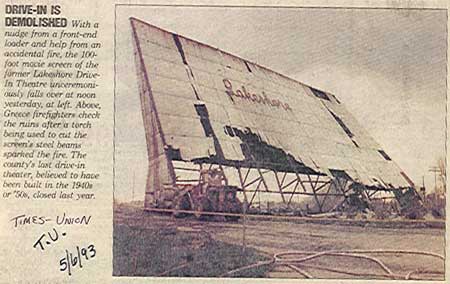|
|
|

Want to research a drive-in? I'll tell you how to do it.
I've
been interested in drive-ins ever since my parents brought me to my first drive-in
movie when I was 5 years old. We went to Lakeshore every summer, until
1993 when the theater was demolished (see picture). Throughout the 1970's and 1980's, drive-ins began to close down rapidly. The biggest reason
for this was that since most drive-ins only had one screen, they couldn't play
many movies at the same time, or show one particular movie for an extended period
of time, so the movie companies denied the drive-ins first run films. This forced
drive-ins to begin playing X rated films and second run old movies that were
already out on video in most cases. Also, the institution of daylight savings
time forced drive-ins to play movies an hour later than usual, and thus had
to let out an hour later. This made many people decide not to go because the
movie would let out too late. More theaters closed in the north than anywhere
else due to the cold and snowy weather. Northern theaters could only stay open
around 5 months out of the year at the most. Engineers developed in-car heaters
that were attached to the speaker poles that you could use to heat your car
while the window was down for the speaker, but those were a failure due to their
high initial purchase and installation costs, and high energy costs.
the 1970's and 1980's, drive-ins began to close down rapidly. The biggest reason
for this was that since most drive-ins only had one screen, they couldn't play
many movies at the same time, or show one particular movie for an extended period
of time, so the movie companies denied the drive-ins first run films. This forced
drive-ins to begin playing X rated films and second run old movies that were
already out on video in most cases. Also, the institution of daylight savings
time forced drive-ins to play movies an hour later than usual, and thus had
to let out an hour later. This made many people decide not to go because the
movie would let out too late. More theaters closed in the north than anywhere
else due to the cold and snowy weather. Northern theaters could only stay open
around 5 months out of the year at the most. Engineers developed in-car heaters
that were attached to the speaker poles that you could use to heat your car
while the window was down for the speaker, but those were a failure due to their
high initial purchase and installation costs, and high energy costs.
Presently, drive-ins are slowly making a comeback by building multiplexes with more than one screen, or adding screens to existing theaters This gives drive-ins the opportunity to obtain first-run films, and show many at one time. Muffled and "crackly" in-car speakers of the old drive-in era are being replaced now with FM stereo sound. Some theaters also have AM broadcast. Now you simply sit in your car with the engine off, and the radio on to listen to the movies. No need to put your windows down and let the bugs in anymore. With modern Solid State electronics in cars, the drain on your car battery for the operation of the radio will be minimal. The newest modern problem I've noticed is people wanting to turn their car on for a minute for some air conditioning, and their daytime running lamps come on, blinding patrons, and fading out the movie on the screen.
For those of you who haven't been to a drive-in in some time, yes, people still beep the horns and flash their headlights at dusk, people still make puppets and gestures into the projection light beam, and the concession stand is still usually a little building in the middle of the lot with the projection booth in front. However, many theaters now are adding full sit down restaurants, ice cream parlors, miniature golf, playgrounds, and amusement rides on site for patrons. As far as I know, sneaking people into the theater in the trunk is no longer popular.
An excellent source for drive-in history is the book: "American Drive-In theaters: A History From Their Inception In 1932" by Kerry Segrave. This book is no longer in print, but can be found at many larger libraries, and many college and university libraries. When I began my research into local theaters, I was shocked at how little research there is on them. So, I guess I'm blazing a new trail! Our local Landmark Society is also interested in my research since they do not have anything on file about our area's past drive-ins.
Now the fun part: researching a past drive-in near you! Many drive-ins are quickly demolished after closure to make way for much more profitable uses of the vast plot of land. Some are left to decay due to a lack of financial resources. And, believe it or not, there are still many open in the U.S. - some even still being built!
Keep reading to find out how you can learn all about that theater you once spent all your summer nights at..........
Next Page | Main IMM Page | Sources Cited
This site is viewed best at a screen resolution of 800x600 or higher.
Please visit my main Drive-In site by clicking the image below:
Last updated September 10, 2001.
Site created, maintained and ©1999-2001 by Travis
H. Beaver, all rights reserved.
Trademarks, corporate logos, and print media are the property
of their respective owners
and have not been altered in any way.